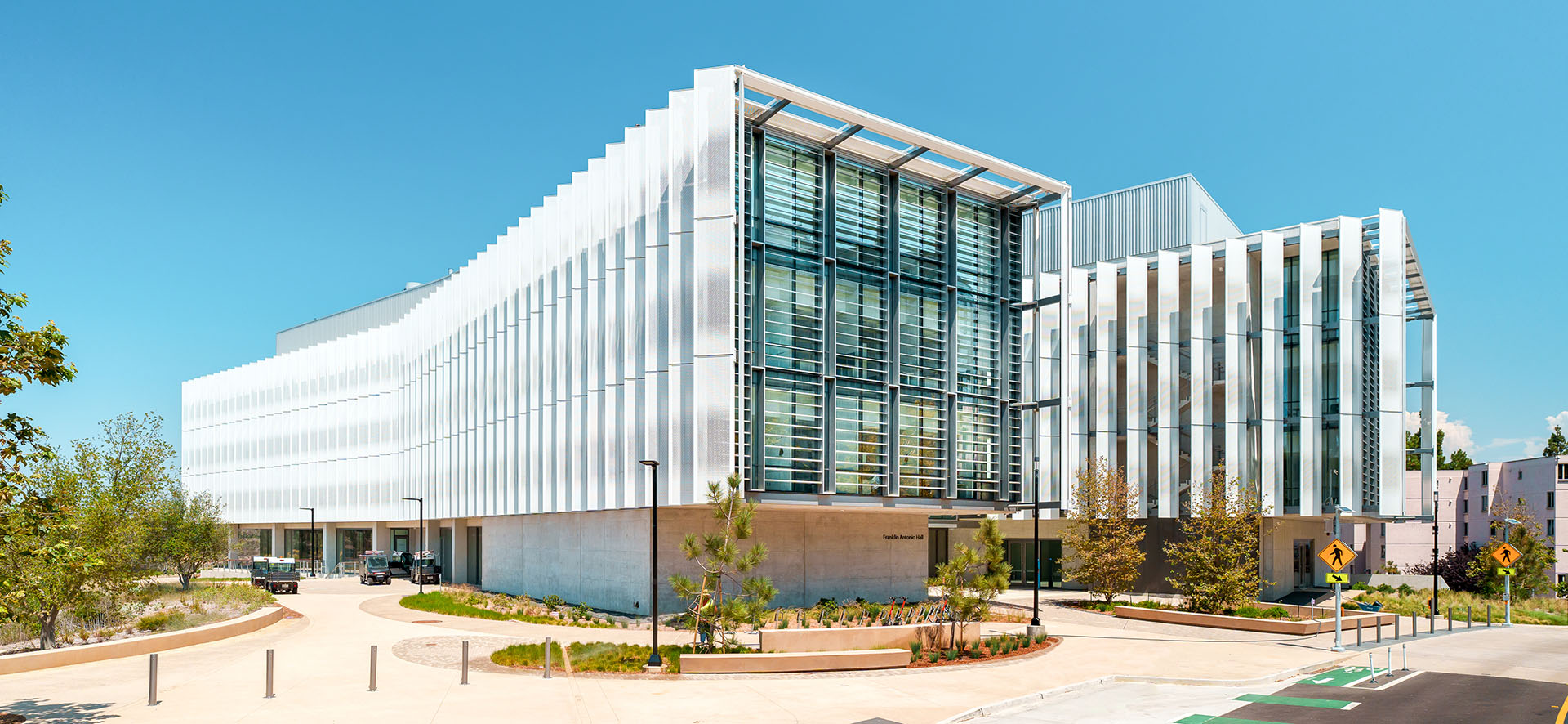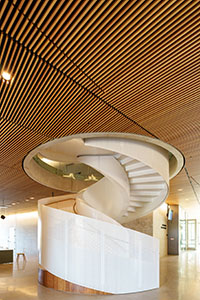Franklin Antonio Hall Earns LEED Platinum Certification
Solar power, recycled water, reduced energy consumption propelled the building to this top recognition
Story by:
Published Date
Article Content
At the University of California San Diego Jacobs School of Engineering, we’re not just conducting crucial research into futuristic sustainable energy technologies; we’re also putting today’s cutting-edge sustainability solutions into practice. The new Franklin Antonio Hall collaborative research building was engineered to incorporate the latest sustainability and efficiency tools, and was recently awarded LEED Platinum certification by the US Green Building Council (USGBC) – the highest level of recognition.
LEED (Leadership in Energy and Environmental Design) designation is awarded to buildings that address carbon, energy, water, waste, transportation, materials, health and indoor environmental quality. Projects go through a verification and review process by the US Green Building Certification Inc., and are awarded points that correspond to a level of LEED certification; Platinum is the highest level. Franklin Antonio Hall is among six UC San Diego projects to achieve Platinum certification.
Franklin Antonio Hall earned these high marks for its all-encompassing approach to sustainability, including low flow fixtures to reduce water consumption by 40 percent; photovoltaic solar panels on the roof for on-site renewable energy generation; reclaimed water supplying 100 percent of the landscaping needs; expanded metering that provides usage loads for HVAC, lighting, plug loads, and equipment; and external aluminum fins that shade the building from sun while allowing those inside to enjoy panoramic views of the canyon.

“It can be especially challenging to obtain LEED Platinum certification for a research-intensive building like Franklin Antonio Hall. I’m proud of the creativity and teamwork we put forth to make it happen,” said Albert P. Pisano, Dean of the UC San Diego Jacobs School of Engineering. “Congratulations once again to everyone who came together to make Franklin Antonio Hall possible. We truly created a machine for collaborative innovation.”
Mark Rowland, project manager for the Franklin Antonio Hall design and build process, has been managing new builds at UC San Diego for two decades. Some of the features he found particularly unique in Franklin Antonio Hall include the vertical, aluminum fins on the exterior of the windows, which eliminate glare on the interior and reduce heat gain to help cool the building while allowing for sweeping canyon views; the landscaping, composed of native plants requiring very little irrigation, 100% of which is sourced from the campus reclaimed water loop; and a clever alternative to connecting to the campus hot water line.
“Franklin Antonio was adamant that this building achieve LEED Platinum certification,” said Rowland. “There were several features, like photovoltaic solar panels on the roof, that were very tricky to execute, but Franklin really pushed us to find creative solutions to make it possible.”
In the case of the solar panels, they sit on essentially a secondary roof, which allows access to the mechanical systems on the building’s actual roof, should any of it need to be fixed or replaced.
The native, drought-resistant plants outside the building blend seamlessly into the canyon that Franklin Antonio Hall sits on. The plants require very little water, 100% of which is sourced from the campus reclaimed water loop. Condensate from the building’s HVAC system feeds into this.
“In the basement of Franklin Antonio Hall, we installed a 5,000-gallon water tank where we collect all the condensate from the air handler units on the roof,” said Rowland. “Through gravity it is fed to the basement, where it’s then pumped into the campus reclaimed water line and used for irrigation– not only on this site, but other building sites on campus as well.”
While the building tapped into the campus chilled water loop to help with cooling, accessing the campus high temperature hot water line – a quarter mile away from Franklin Antonio Hall – posed a serious challenge. The team decided to find a creative, and more sustainable, solution.
“There were several things that we did that put us over the top to get platinum. One of the things that we did that I think is really unique, that we haven't utilized in very many buildings, was to actually not tap into the campus high temperature hot water line to create hot water for the building,” said Rowland.
“Instead, we take the heat out of the chilled water as it returns from cooling the building, to create the hot water we need to heat the building and to create the domestic hot water. Basically, it works something like this - chilled water enters the building at 40 degrees, and after we use it to cool the building and equipment, typically it is then pumped back into the campus loop in the street at around 60 degrees. We utilize a heat pump system to extract the heat that the chilled water gained, and put it back in the building to create domestic hot water and heat the building.”


Innovative building organization
The 186,000 square foot building is not only innovative in its architecture and sustainability features, it’s also ground-breaking in how research teams are organized within the building. It is home to 13 collaboratories–research laboratories bringing together researchers from different departments to solve a wide range of problems facing society.
Learn more about the research underway in Franklin Antonio Hall here.
The building is named after UC San Diego alumnus Franklin Antonio in recognition of his incredible $30 million gift to the UC San Diego Jacobs School of Engineering. Antonio, who co-founded Qualcomm, passed away in May 2022.
Share This:
You May Also Like
UC San Diego is Strengthening U.S. Semiconductor Innovation and Workforce Development
Technology & EngineeringStay in the Know
Keep up with all the latest from UC San Diego. Subscribe to the newsletter today.




